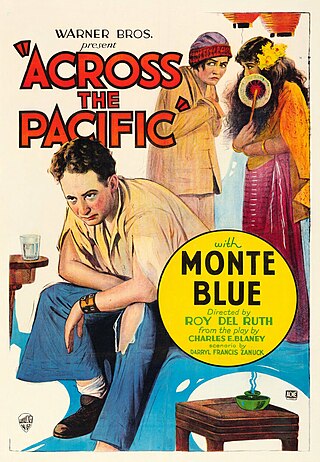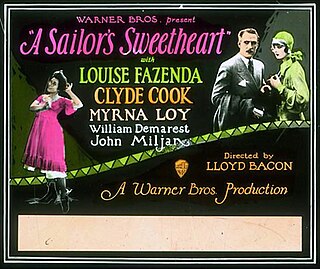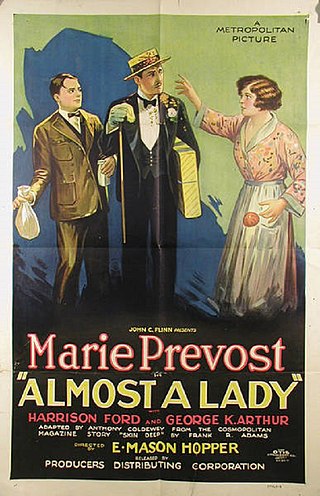
Don Juan is a 1926 American romantic adventure film directed by Alan Crosland. It is the first feature-length film to utilize the Vitaphone sound-on-disc sound system with a synchronized musical score and sound effects, though it has no spoken dialogue. The film is inspired by Lord Byron's 1821 epic poem of the same name. The screenplay was written by Bess Meredyth with intertitles by Maude Fulton and Walter Anthony.

His Jazz Bride is a 1926 American silent drama film released by Warner Brothers Pictures. The movie starred Marie Prevost and Matt Moore.

The Crimson City (1928) is an American silent drama film produced by Warner Bros. written by Anthony Coldeway and directed by Archie Mayo. Actors include Myrna Loy, Anna May Wong, Sōjin Kamiyama, John Miljan, Leila Hyams and Richard Tucker. The film was released with a Vitaphone soundtrack with a music score and sound effects. The film was released by Warner Brothers Pictures on April 7, 1928.

The Midnight Taxi is a 1928 American early part-talkie thriller picture from Warner Bros. directed by John G. Adolfi and starring Antonio Moreno, Helen Costello, and Myrna Loy. According to the Library of Congress, it has a completed copy of the film and found at British Film Institute's National Film and Television Archive.

Pleasures of the Rich is a 1926 American silent romantic drama film directed by Louis J. Gasnier and produced by Tiffany Pictures with a general distribution through Renown Pictures. The film featured several well known performers of the time, such as Helene Chadwick, Jack Mulhall, Hedda Hopper, and Mary Carr.

Across the Pacific is a lost 1926 American silent romantic adventure film produced by Warner Bros., directed by Roy del Ruth and starring Monte Blue. It was based on a 1900 play by Charles Blaney and J. J. McCloskey. The play had been filmed before in 1914 with Dorothy Dalton. It is unknown, but the film might have been released with a Vitaphone soundtrack.

State Street Sadie is a 1928 American crime drama film directed by Archie Mayo, and released as a silent film with talking sequences using Warner Bros.' Vitaphone sound-on-disc process. This is regarded as a lost film.

The Great Divide is a 1929 American pre-Code Western film directed by Reginald Barker and starring Dorothy Mackaill. Released in both silent and sound versions, it was produced and distributed by First National Pictures. The film is a remake of The Great Divide, made at MGM in 1925 and also directed by Barker. There was another remake in 1931 as the full sound film Woman Hungry. All three films are based on the 1906 Broadway play The Great Divide by William Vaughn Moody.

Companionate Marriage was a 1928 American silent drama film directed by Erle C. Kenton and starring Betty Bronson, and released by First National Pictures. The film is now considered lost.

Matinee Ladies was a 1927 American silent comedy film produced and distributed by Warner Bros. Directed by Byron Haskin, the film starred May McAvoy and was Haskin's first directorial effort after having been a cinematographer. Matinee Ladies is now considered lost.

The Squall is a 1929 American pre-Code drama film directed by Alexander Korda and starring Myrna Loy, Richard Tucker, Alice Joyce and Loretta Young, and based on the 1926 play The Squall by Jean Bart.

A Sailor's Sweetheart is a 1927 Warner Bros. silent film comedy directed by Lloyd Bacon. It stars Louise Fazenda and Clyde Cook. It was released with a Vitaphone soundtrack with a music score and sound effects.

Why Girls Go Back Home is a lost 1926 American silent comedy drama film produced and distributed by Warner Bros. James Flood directed and Patsy Ruth Miller and Clive Brook starred. Myrna Loy has a feature role. The film is a sequel to Warner Bros.'s 1921 Why Girls Leave Home, which was a box office hit.

The Lover of Camille is a 1924 American silent romantic drama film directed by Harry Beaumont, and starring Monte Blue. The film was based on the French play Deburau by Sacha Guitry, which was also adapted into a Broadway play by Harley Granville-Barker.

The Girl from Chicago is a lost 1927 American silent criminal romantic drama film directed by Ray Enright and starring Myrna Loy and Conrad Nagel. It was produced and distributed by the Warner Bros. and is based upon a short story by Arthur Somers Roche that appeared in the June 1923 Redbook. The film later had a Vitaphone soundtrack of sound effects and music added.

Beware of Married Men is a 1928 American comedy film directed by Archie Mayo and starring Irene Rich, Clyde Cook and Audrey Ferris. It was produced and distributed by Warner Brothers with a Vitaphone track.

Pay as You Enter is a 1928 American comedy film directed by Lloyd Bacon and starring Louise Fazenda, Clyde Cook and William Demarest.

Almost a Lady is a 1926 American silent romantic comedy film directed by E. Mason Hopper and starring Marie Prevost.

The Love Toy is a 1926 American silent comedy film directed by Erle C. Kenton and starring Lowell Sherman, Jane Winton, and Willard Louis. The film was produced and distributed by Warner Brothers.

Getting Gertie's Garter is a 1927 American silent comedy film directed by E. Mason Hopper and starring Marie Prevost, Charles Ray and Sally Rand. It is an adaptation of the 1921 play of the same name by Wilson Collison and Avery Hopwood.




















